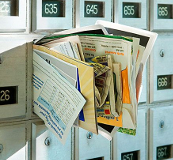WHAT IS JUNK MAIL AND WHAT HAPPENS TO YOUR’S
Merriam-Webster describes junk mail as unsolicited mail that consists mainly of promotional materials, catalogs, and requests for donations. Advertising mail accounts for 59 percent of all mail Americans receive. But only half of that mail is ever read, according to the United States Postal Service. The term was first used in 1954. “How did I get on those junk mailing lists?” you might ask. Perhaps you gave a company your name and contact information when you ordered a product. Your name can be gathered if you buy a house or a car, ordered a product from another catalog, participate in a store’s loyalty program, or send in a charitable donation. A company can “rent” a list of names from similar companies.
Junk mail can be a huge cause of pollution in our landfills. That is why when junk mail arrives for a Texas Home Base client it is gathered in a tub and periodically a company comes to shred the junk mail on site. We are given a Certificate of Destruction by the company allowing Texas Home Base to comply with all Federal and State privacy laws. You can see more about Albert Records Management here.
How do we know the mail is “junk”? Catalogs, promotional material, credit card solicitations, and requests for donations are usually marked “presorted standard”. That tells us the mail is more than likely junk. If there is ever a question in our minds we will err on the side of caution and send the piece of mail to our client. We open the envelope and if there is a question we will write on the envelope to send it. We also have a place in our paperwork that our client can mark if they do not want junk mail, magazines, and non-profit mail forwarded. If the client does want all mail sent they will not mark those choices. The postage to send all junk mail can be quite costly. So we are happy to provide the shredding service at no extra cost to our clients.

